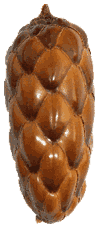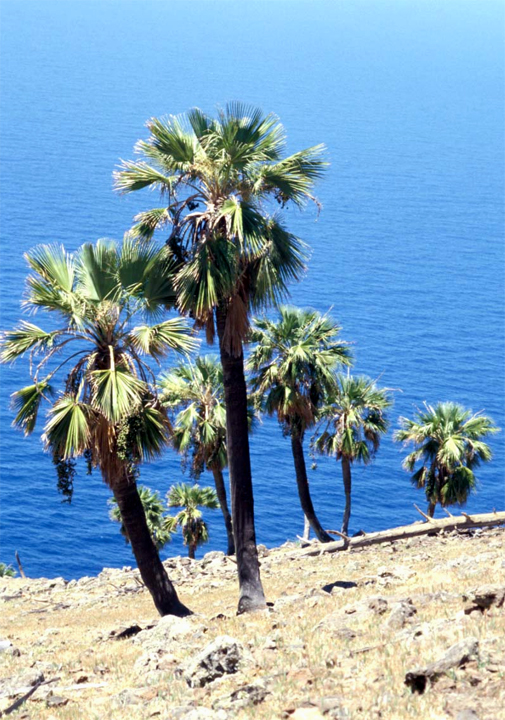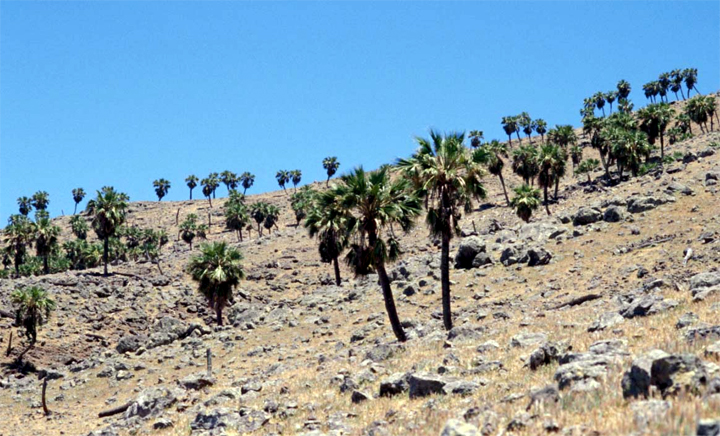 |
Palm |
 |
Palm |
Brahea edulis is endemic to Guadalupe Island, Mexico, a small oceanic island (254 km2) in the Pacific, 241 km off the coast of Baja California. It is part of the California Floristic Province Hotspot (sensu Conservation International). This species is widely cultivated in southern Europe, southern California and other areas with mild, Mediterranean climates.
This species is the only palm found on Guadalupe Island. It is a large fan palm with a stocky, solitary trunk. The leaves are uniformly green, and the petioles usually lack any teeth. The inflorescence is about as long as the leaves. Brahea edulis has the largest, fleshiest fruit of the genus, ca. 25–27 mm in diameter. The fruits are edible.
The type specimen of this species was first collected in 1875 by Edward Palmer, and the name was formally published by Sereno Watson in 1880. In the older literature, the species is known by the synonym Erythea edulis.
Recent expeditions to Guadalupe found that the palm grows at 150–900 m elevation on the northwest side of the island. At higher elevations, a few palms may be found scattered among oaks and pines. A few scattered stands are found in the southern half of the island. It is likely that the palm was more abundant at the time of its discovery by Palmer, although even Palmer noted that his botanical collecting was hampered by goats, who ate all the easily accessible vegetation. Bailey, in 1937, noted that the palm was “becoming rare” on the island.
Little is known about Brahea edulis in its remote natural habitat, but it is believed to flower in March and April.
Famed Santa Barbara horticulturist F. Franceschi, who visited the island in 1892, claimed in 1895 that the species had been in cultivation in southern California for “at least 30 years.” The palm is well known in cultivation, where it flowers and fruits prodigiously.
 |
| Brahea edulis in the wild. Photo by Jon Rebman. |
Feral goats, originally introduced by Russian trading vessels in the 19th Century, have denuded the island of natural vegetation, and as fast as seedlings of Brahea edulis germinated, they were consumed by goats. Habitat destruction by feral goats is the clear and present threat to Brahea edulis. Goats are already responsible for the extinction of approximately 25 plant taxa and three endemic birds (by destroying nesting habitat) on Guadalupe. More than 20,000 goats were removed from the island in 1971, reportedly leaving only 239 animals, but the population rebounded to at least 7000 by 1994. An expedition by the San Diego Natural History Museum in June 2000 reported that thousands of feral goats still roamed the island. By 2003, the goat population was estimated to be 2000.
No palm seedling survive predation by goats. The goats were observed to eat foliage from those mature palms that had inclined trunks that the goats could climb. They even eat the outer cortex (bark) from mature palms. The remaining senescent palms are past their reproductive prime.
At present, introduced plants do not directly effect the mature Brahea edulis palms on the island, but if the goats are removed and the palm is allowed to regenerate, exotic plants may compete with seedling palms. Likewise, the soil erosion that has occurred since goats denuded the island is a potential threat to the regeneration of the palm in its habitat. The significance of soil erosion to the regeneration of the palm cannot be determined at this time.
Guadalupe Island was given protection by the Mexican government in 1928, when it was declared a Special Biosphere Reserve. Attempts to remove goats from the island were initiated during the late 20th century. Complete eradication was never achieved, and the goat population always rebounded. Twelve fenced exclosures were built in 2001 by a coalition that included the Mexican government, Mexican Navy, the local fishing cooperative, Seacology Foundation, and the Island Conservation and Ecology Group. Subsequent study of the exclosures found remarkable regeneration of native and introduced plants, prompting researchers to conclude that much of the island’s flora could be recovered if the goats could be eradicated.
If the palm is to survive, all goats must be completely and permanently removed from the island without delay. This action, more than any other, is needed to save this palm from extirpation from Guadalupe. This action will also have a positive effect on the remaining endemic plants and animals on the island.
An assessment of the genetic diversity of ex situ collections versus remaining wild adults would be very useful. Although this species has been in cultivation in the USA and southern Europe since the 1890s, we know little about how this species was introduced into horticulture. Plants in cultivation in Europe, Australia and the Americas may be descendents of a single introduction and may not adequately represent the genetic diversity present in the wild. There is a need for the establishment of genetically diverse ex situ breeding population. We do not know if this species hybridizes with other species of Brahea or other palms in garden settings. Hybridization is an obvious threat to ex situ collections, and research on this threat is needed.
Monitoring the remaining population on Guadalupe Island is critical. If the feral goat can be permanently eradicated, monitoring the expected regeneration of the flora will determine if the palms can regenerate without human intervention. If regeneration is inadequate, out-planting of seedlings raised from ex situ plants may be necessary.
Dr. Scott Zona, FTBG
 |
| Brahea edulis in the wild. Photo by Jon Rebman. |
Bailey, L.H. 1937.
Erythea – the Hesper palm.
Gentes Herb. 4: 84–118.
Franceschi, F. 1895.
Santa Barbara exotic flora: a handbook of plants from foreign countries grown at Santa Barbara, California.
Santa Barbara, California.
Junak, S., B. Keitt, B. Tershy, D. Croll, L. M. Luna-Mendoza & A. Aguirre-Muñoz. 2005.
Esfuerzos recientes de conservación y apuntes sobre el estado actual de la flora de Isla Guadalupe, Baja California, México, in K. Santos del Prado & E. Peters (eds.)
Isla Guadalupe, Restauración y Conservación.
Insituto Nacional de Ecología (INE SEMARNAT), Mexico. <http://www.ine.gob.mx/publicaciones>
León de La Luz, J.L., J. Rebman, T. Oberbauer. 2005.
El estado actual de la flora y vegetación de Isla Guadalupe, in K. Santos del Prado & E. Peters (eds.)
Isla Guadalupe, Restauración y Conservación.
Insituto Nacional de Ecología (INE SEMARNAT), Mexico. <http://www.ine.gob.mx/publicaciones>
Moran, R. 1996.
The Flora of Guadalupe Island, Mexico.
Memoirs Calif. Acad. Sci. 19.
Sweet. P.R., G. F. Barrowclough, J. T. Klicka, L. Montañez-Godoy & P. Escalante-Pliego. 2001.
Recolonization of the Flicker and Other Notes from Isla Guadalupe, Mexico.
Western Birds 32: 71–80.